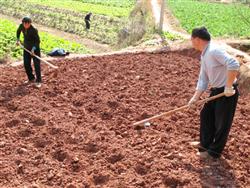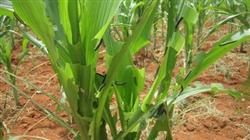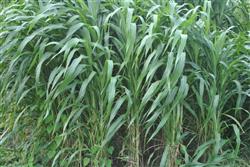Sweet sorghum planting technology: how to manage sweet sorghum?

How to manage sweet sorghum? Also ask netizens to help introduce the planting and management of sweet sorghum can refer to the following listed methods. 1. Fine soil preparation and adequate base fertilizer. Because the seed of sweet sorghum is small and the ability of top soil is weak, it grows slowly in the early stage and needs more water and fertilizer in the middle and later stage. Therefore, the land should be deep, flat, fine and broken, get rid of weeds, apply sufficient base fertilizer, combine soil and fertilizer, and rake pressure to preserve soil moisture. 2. Sowing seeds at the right time to ensure the whole seedling. Sowing at the right time and mastering the depth is the key to cultivation. The growth period of sweet sorghum is generally long, so it is very important to sow seeds timely and make full use of frost-free season to achieve maturity in Huaibei spring sowing area. The sowing depth is about 3.3 cm. 3. Early tillering to promote a strong seedling. Sweet sorghum varieties have strong tillering ability, and the general tillers are more than 2-3 plants, and the tillers are strong. If they are not removed as soon as possible, the branches of the main stem will grow mixed, consume nutrients, prolong the growth period of the main stem, and cause adverse consequences such as softness and late ripening of the main stem. For this reason, the tillers should be removed in time after the seedlings are fixed, so as to promote the sturdy main stem and produce more stems. 4. Reasonable close planting. Sweet sorghum has tall plants and luxuriant stems and leaves, so the planting density should not be too high, and it is suitable to keep 5000-6000 plants per mu. 5. Strengthen management and promote seedling growth. Sweet sorghum seedling growth is slow, and the growth period is long, need diligent management, more hoe, to ensure that the soil is loose without grass, promote the rapid growth of seedlings. 6. Use water and fertilizer skillfully. It is required to apply sufficient base fertilizer and increase phosphate fertilizer to facilitate sugar accumulation. In the middle and later stage of planting sweet sorghum, it is not suitable to apply too much nitrogen fertilizer, so as to avoid greedy growth and affect the accumulation of sugar in the stem and the normal maturity of grains, which is the key to fertilization. Topdressing nitrogen fertilizer can determine the amount of topdressing fertilizer according to soil fertility and seedling growth at jointing stage. In general, 30 kg of nitrogen fertilizer per mu can be applied. After topdressing, water shallow hoe, dry land can grasp the rain before topdressing, ploughing after rain. Cultivate the soil after heading and master the use of water according to the drought. If too much watering, it is easy to cause tall plants, the root soil will lodge when the wind is soft. 7. Pay attention to pest control: sweet sorghum has strong disease resistance, but poor insect resistance. Because of the high sugar content in stems and leaves, it is easy to be harmed by drills and aphids. The harm of the drillworm can make the stem inverted and the intramedullary juice change color and bitterness. Aphids damage leaves affect the formation of photosynthate, resulting in the decrease of sugar content. Paying attention to pest control and early pest control is an important link to obtain high stem weight and high sugar content. 8. Give consideration to both grain and stalks and harvest at the right time. The highest sugar content in sweet sorghum stalk is synchronized with grain maturity, and it is also the highest sugar content after grain maturation. If the plant begins to die or encounter frost, the sugar content in the stem will decrease. Therefore, once the sweet sorghum is ripe, it should be harvested in time, so that the grain stalk is taken into account and the benefit is the best. Click to get more sorghum planting technology click to get more grain planting technology
- Prev

How to control the corn armyworm?
How to control the corn armyworm? What is the corn armyworm? What kind of pesticide does corn armyworm hit with? The corn armyworm, also known as the five-color worm, has miscellaneous food habits. The adults lie dormant during the day and come out at night. Most of them lay eggs in the withered and yellow leaf tips and leaf sheaths of the middle and lower parts of wheat. A single female lays 1000 / 2000 eggs. The larvae are mostly active in the morning and evening, that is, in the morning.
- Next

Sweet Sorghum planting Technology: is Sweet Sorghum good?
Is sweet sorghum good to grow? There are no netizens to provide planting technology sweet sorghum as a high-quality forage grass, with high sugar content, high protein content, rich nutritional value, good palatability, strong adaptability and other characteristics, is herbivorous livestock like to eat forage grass, deeply loved by the majority of farmers. The following is the sweet sorghum species arranged by the planting network.
Related
- The first cup of black tea in spring, the flavor and history of tea gardens in Kenya, Africa
- The computer can not only choose potatoes, but also grow tea rice. AI will grow winter oolong tea champion.
- It is not only the inflated tea bitten by insects, but also engraved with the four seasons tea in Beipu.
- The Oriental Beauty Tea Festival in Zhuxian County takes the stage at the weekend to experience the plus-size feast of oil tea.
- & quot; Oriental Beauty Tea & Exploration of Emei in Hsinchu, the hometown of quot;
- The new variety of strawberry "Tainong 1" dessert is the first choice with mellow aroma. Crimson gorgeous
- History of Tea in Taiwan: from Wild Inner Mountain to Export Tea Garden
- Two types of Taiwan Oriental Beauty Black Tea won the British three-Star Award for Childhood Tea Xiang Zhang Jiaqi changed from pilot to champion tea maker.
- Banana species and varieties: the planting history of Taiwan Xianren banana and dwarf banana is long, is banana disease resistant?
- Coffee planting Technology: Qianjie Coffee from Seedling to harvesting

